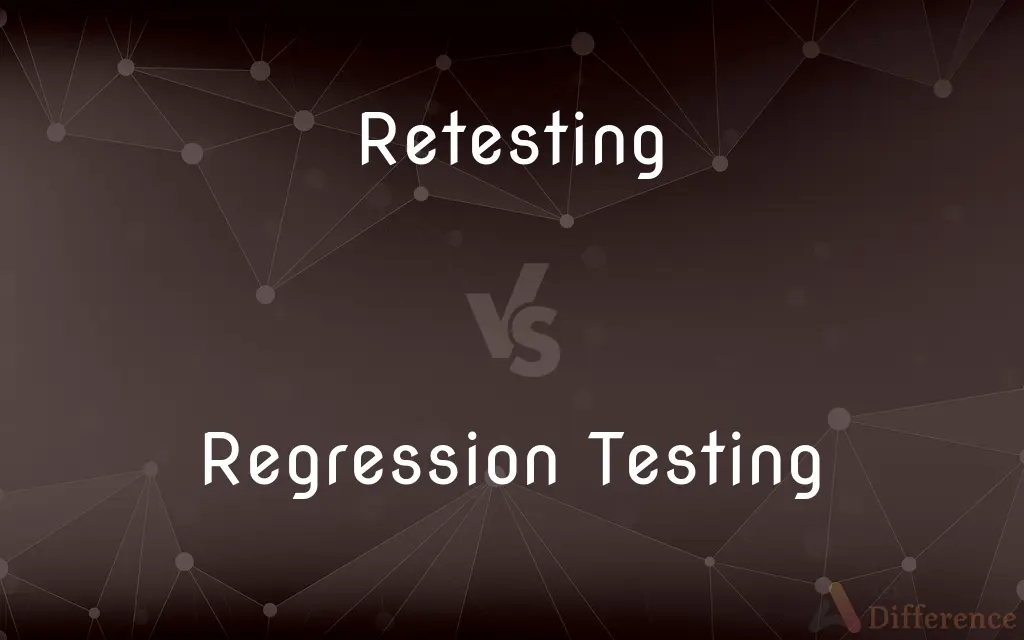Retesting vs. Regression Testing — What's the Difference?
By Tayyaba Rehman & Urooj Arif — Published on February 9, 2024
Retesting verifies fixed defects; regression testing checks if new changes haven't adversely affected existing functionalities.

Difference Between Retesting and Regression Testing
Table of Contents
ADVERTISEMENT
Key Differences
Retesting involves re-running tests on the specific functionality that was previously found to be defective, to ensure the defect has been successfully fixed. In contrast, regression testing is performed to ensure that recent changes or fixes have not introduced new faults into existing unaffected areas of the software.
While retesting is focused on verifying the fixes of identified defects, regression testing is broader, aiming to uncover any unintended side effects caused by new changes in the software. Retesting is usually planned with a specific set of test cases, whereas regression testing often involves running a larger set of tests that cover both new and existing functionalities.
Retesting is a targeted approach, often confined to the area where a defect was fixed, ensuring the fix works as intended. Regression testing, however, takes a more holistic view, scrutinizing the software to catch any errors that might have crept in elsewhere as a result of the changes.
The objective of retesting is to confirm that the specific issues addressed have been resolved, making it a focused and narrow scope activity. On the other hand, regression testing serves a preventive purpose, aiming to detect any problems that could disrupt the software's existing functionality, thereby having a wider scope.
In the software development lifecycle, retesting is performed after a defect has been fixed, often in the same phase of testing. Regression testing, however, is typically carried out after retesting and can be repeated at various stages throughout the development process, especially after significant changes.
ADVERTISEMENT
Comparison Chart
Purpose
To verify defect fixes
To ensure new changes haven't introduced errors
Scope
Narrow, focused on fixed areas
Broad, covering areas beyond recent changes
Test Cases
Specific to the defect
Extensive, covering unaffected functionalities
Frequency
Conducted once after a fix
Repeated at various stages of development
Objective
Confirming the resolution of identified issues
Ensuring overall software integrity remains intact
Compare with Definitions
Retesting
Targeted testing post bug-fix implementation.
The QA team's retesting efforts confirmed that the software behaved as expected after the fixes.
Regression Testing
The practice of verifying unchanged software parts after modifications.
The team conducted regression testing to ensure new updates did not disrupt existing features.
Retesting
Verification of specific bug fixes.
After the patch was applied, retesting was performed to ensure the application's functionality was restored.
Regression Testing
Comprehensive testing to ensure new changes do not affect existing functionality.
Regression testing was performed after the new feature integration to ensure system stability.
Retesting
The process of checking corrected defects.
Retesting confirmed the bug fix resolved the issue without introducing new errors.
Regression Testing
Ensuring software enhancements do not introduce new issues.
After adding new functionalities, regression testing was essential to ensure the application's reliability.
Retesting
Re-evaluation of software after defect correction.
The development team carried out retesting to validate the effectiveness of the recent fix.
Regression Testing
Repeated testing to detect newly introduced errors.
Following the system upgrade, regression testing was crucial to maintain software quality.
Retesting
Focused testing on previously failed areas.
Retesting was crucial to ascertain that the previously identified errors were adequately addressed.
Regression Testing
Systematic testing of software to prevent new defects in existing functionality.
To preserve the integrity of the application, regression testing was carried out extensively.
Retesting
To test again.
Retesting
A second or repeated test.
Retesting
Infl of retest
Common Curiosities
What is regression testing?
Regression testing is the process of testing the unchanged parts of the application to ensure that new changes haven't introduced any new defects.
What is retesting in software testing?
Retesting is the process of testing specific functionality after defects have been fixed to ensure the fixes work as intended.
Is regression testing broader than retesting?
Yes, regression testing has a broader scope as it covers more areas of the application beyond the recently changed or fixed parts.
How are test cases selected for retesting?
Test cases for retesting are selected based on the specific defect that was fixed.
Can retesting and regression testing overlap?
While they have different focuses, retesting and regression testing can overlap if a previously fixed area is included in the regression test suite.
When is retesting performed?
Retesting is performed after a defect has been fixed and the solution is implemented.
What challenges are associated with regression testing?
Challenges include maintaining an up-to-date test suite and ensuring adequate coverage without unnecessarily increasing testing time.
How does retesting contribute to software quality?
Retesting ensures that specific fixes are effective, thereby directly contributing to the overall quality of the software.
How often is regression testing done?
Regression testing is done frequently throughout the software development lifecycle, especially after each significant change.
What is the main goal of regression testing?
The main goal of regression testing is to ensure that new code changes have not adversely affected existing functionalities.
Why is retesting important?
Retesting is important to verify that specific bugs have been correctly fixed and do not persist.
Can automated testing be used for retesting and regression testing?
Yes, automated testing is commonly used for both retesting and regression testing to increase efficiency and coverage.
What strategies can optimize regression testing?
Strategies include prioritizing test cases, using automated testing tools, and regularly reviewing and updating test suites.
Are retesting and regression testing only relevant for certain types of software?
No, retesting and regression testing are relevant for all types of software development projects to ensure quality and reliability.
What determines the extent of regression testing?
The extent of regression testing is determined by the scope of recent changes and the critical areas of the application.
Share Your Discovery

Previous Comparison
Cardinal Numbers vs. Nominal Numbers
Next Comparison
Automotive Engineering vs. Automobile EngineeringAuthor Spotlight
Written by
Tayyaba RehmanTayyaba Rehman is a distinguished writer, currently serving as a primary contributor to askdifference.com. As a researcher in semantics and etymology, Tayyaba's passion for the complexity of languages and their distinctions has found a perfect home on the platform. Tayyaba delves into the intricacies of language, distinguishing between commonly confused words and phrases, thereby providing clarity for readers worldwide.
Co-written by
Urooj ArifUrooj is a skilled content writer at Ask Difference, known for her exceptional ability to simplify complex topics into engaging and informative content. With a passion for research and a flair for clear, concise writing, she consistently delivers articles that resonate with our diverse audience.













































